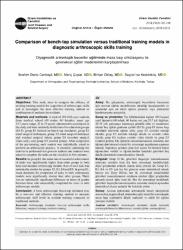| dc.contributor.author | Canbeyli, Ibrahim Deniz | |
| dc.contributor.author | Cirpar, Meric | |
| dc.contributor.author | Oktas, Birhan | |
| dc.contributor.author | Keskinkilic, Seyyid Isa | |
| dc.date.accessioned | 2020-06-25T18:29:53Z | |
| dc.date.available | 2020-06-25T18:29:53Z | |
| dc.date.issued | 2018 | |
| dc.identifier.citation | Canbeyli İ. D., Çırpar M., Oktaş B., Keskinkılıç S. İ. (2018). Comparison of bench-top simulation versus traditional training models in diagnostic arthroscopic skills training. Eklem Hastalıkları ve Cerrahisi Dergisi (Eski Adı: Artroplasti Artroskopik Cerrahi Derg.), 29(3), 130 - 138. | en_US |
| dc.identifier.issn | 1305-8282 | |
| dc.identifier.issn | 1309-0313 | |
| dc.identifier.uri | https://doi.org/10.5606/ehc.2018.61213 | |
| dc.identifier.uri | https://hdl.handle.net/20.500.12587/7492 | |
| dc.description | Canbeyli, Ibrahim Deniz/0000-0003-3880-4779 | en_US |
| dc.description | WOS: 000449003900002 | en_US |
| dc.description | PubMed: 30376796 | en_US |
| dc.description.abstract | Objectives: This study aims to compare the efficacy of existing training models for acquisition of arthroscopic skills and to investigate the most effective training method or combination of methods for residents. Materials and methods: A total of 100 fifth-year students from medical school (40 males, 60 females; mean age 23.7 years; range, 22 to 33 years) volunteered to participate in the study and were randomly divided into five education groups (E1-5): group E1 (trained on bench-top simulator), group E2 (read surgical technique), group E3 (read surgical technique and watched surgical video), group E4 (watched surgical video only), and group E5 (control group). After completion of the pre-training, each student was individually asked to perform an arthroscopy practice. A checklist containing the tasks to be performed w as gig en to students and students were asked to complete the tasks on the checklist in five minutes. Results: In group E1, the mean rate of successful achievement of tasks was significantly higher than other groups in both knee and shoulder arthroscopy models. Rate of each task was statistically similar for groups E2, E3, E4 and E5. In group E1, mean durations for completion of tasks in both arthroscopy models were significantly shorter than other groups. There was no statistically significant difference in terms of gender between those who successfully completed the tasks in both arthroscopy models. Conclusion: A basic arthroscopic bench-top simulator may be a low-cost and effective training method to increase arthroscopic skill levels in resident training compared to traditional methods. | en_US |
| dc.language.iso | eng | en_US |
| dc.publisher | Turkish Joint Diseases Foundation | en_US |
| dc.relation.isversionof | 10.5606/ehc.2018.61213 | en_US |
| dc.rights | info:eu-repo/semantics/openAccess | en_US |
| dc.subject | Arthroscopic simulator | en_US |
| dc.subject | low-cost arthroscopic skills laboratory | en_US |
| dc.subject | surgical training | en_US |
| dc.subject | residents training | en_US |
| dc.title | Comparison of bench-top simulation versus traditional training models in diagnostic arthroscopic skills training | en_US |
| dc.type | article | en_US |
| dc.contributor.department | Kırıkkale Üniversitesi | en_US |
| dc.identifier.volume | 29 | en_US |
| dc.identifier.issue | 3 | en_US |
| dc.identifier.startpage | 130 | en_US |
| dc.identifier.endpage | 138 | en_US |
| dc.relation.journal | Eklem Hastaliklari Ve Cerrahisi-Joint Diseases And Related Surgery | en_US |
| dc.relation.publicationcategory | Makale - Uluslararası Hakemli Dergi - Kurum Öğretim Elemanı | en_US |
















